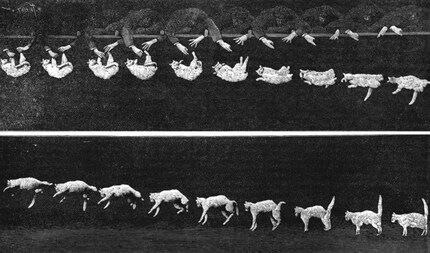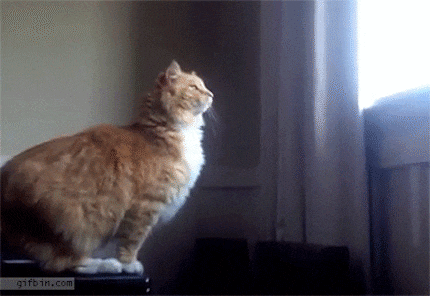
Guide
Keep your cat cool with these 3 top tips
by Patrick Vogt

It’s often said that cats survive every fall unscathed. In today’s Fact Check, we put this claim to the test – and reveal the secret of falling cats.
What would you do if you had several lives? Would you try your hand at being a free runner (article in German) or imitate Tom Cruise’s spectacular motorcycle jump (article in German) over a cliff?
As the saying goes, cats have nine lives. They are true stunt savants. You’ve probably heard of house cats surviving falls from high-rise buildings. In Chicago, for example, a cat saved itself a few years ago by jumping from the fifth floor of a burning building:
Tom Cruise can only dream of this.

But how do cats always manage to land on their feet? Or is it just a myth?
As befits action heroes, cats have a special superpower – their positioning reflex. In the event of a fall, they can align their body so that they land with their legs pointing downwards. This phenomenon has driven scientists to despair for decades. According to the laws of physics, a rotating body should continue to rotate while falling if no other force is acting on it. Not the case with cats. They can stop rotating and even reduce their falling speed. But how?
The great mystery was solved in 1894. French scientist Étienne-Jules Marey recorded slow-motion footage of falling cats, discovering a very specific turning process.
If a cat falls, it first uses its vestibular organ in the inner ear to orient itself. The organ works like a spirit level, indicating its position in relation to the floor. Then the procedure is as follows:
The cat pulls in its front legs, accelerating the rotation of its front body. Similar to a figure skater doing a pirouette.
The cat’s rear body rotates in the opposite direction at the same time thanks to its flexible spine. This stops its angular momentum and stabilises the feline in the air.
As soon as the cat’s front body is pointing downwards, it pulls up its hind legs. As a result, those also speed towards the ground.
Now the cat bends its back and stretches out all its legs. As a result, its body size expands and air resistance increases. The result – fall speed is reduced. It sails downwards like a flying squirrel.
With its muscular legs, the cat cushions its impact like a shock absorber.

Sounds reliable. But do cats really always land on their feet like this? However nice that’d be, the answer to this Fact Check is: no. Here’s why:
Whether the cat remains unharmed depends on the height of the fall. Most injuries occur up to a height of around seven storeys. After that, the chance of survival increases again. This is because the cat has more time to make a life-saving turn in the air if it’s falling from a higher floor.
Overweight cats are much less likely to land on their four paws. This is because the excess kilos impair their ability to align themselves in the air. Those extra fat rolls are of little use on impact.

Cats with short or missing tails won’t necessarily die from falls, but they’re more at risk since they’re less able to keep their balance in the air and take longer to align themselves. Depending on the height of the fall, this can be fatal.
If your cat falls from a great height, don’t take it too lightly. Even if you don’t spot a problem at first glance, your cat may have internal injuries. So always take them to the vet to be on the safe side.
What I don’t recommend at all – sticking a piece of toast on your cat’s back. Preventing an impact and endlessly generating electricity won’t work, even if this – not entirely serious – ad suggests exactly that:
Has your cat ever fallen from a great height? Did it land on its paws and survive? Tell me about it in a comment
I love anything with four legs or roots - especially my shelter cats Jasper and Joy and my collection of succulents. My favourite things to do are stalking around with police dogs and cat coiffeurs on reportages or letting sensitive stories flourish in garden brockis and Japanese gardens.
Practical solutions for everyday problems with technology, household hacks and much more.
Show all